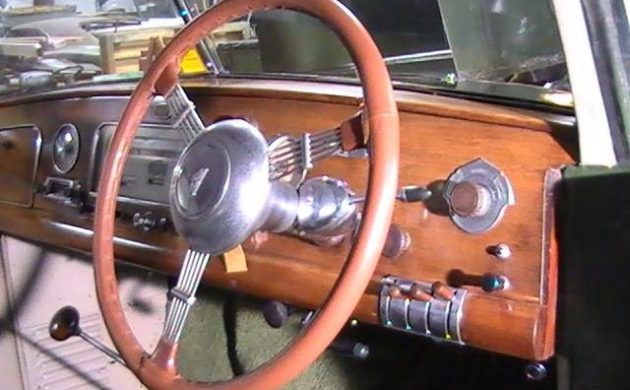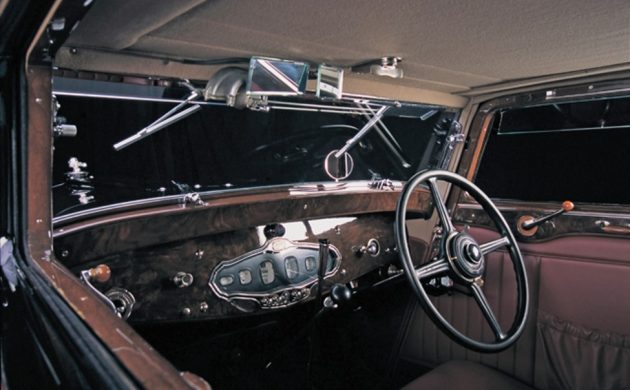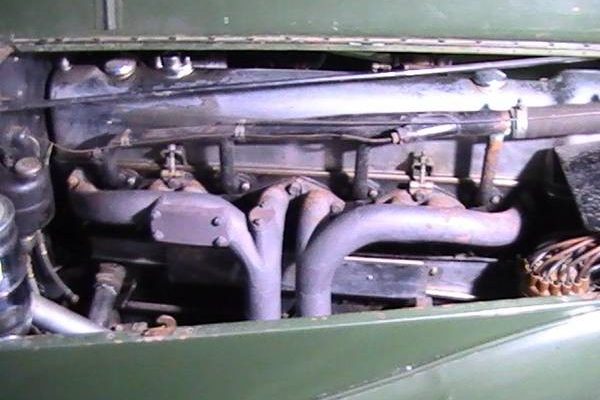And now for something completely different. Right off the bat, BF apologizes for the unintended fuzziness of the original photos of the subject car. The car pictured above, started life as a 1929 Stutz M27 Cabriolet, according to the seller, who is listing the car for sale here on craigslist, with an asking price of $49,900. So there’s a rare 1929 Stutz for sale on craigslist? Wow! Here’s what we expected to find:
Hmmph. This photo above is NOT the car for sale, but a comparable Stutz of the same era to give you some perspective. Even with the imperfect photos of the craigslist car, it’s not hard to conclude that something has been modified in our subject car. Why yes, you’ve got it right if you suggested that our subject car indeed has been stripped of the spare tire mounted near the cowl amidships. Good eye!
But wait, there’s more. Back to our subject car: from the rear, it appears that a great deal of high-quality coachwork has gone into making this classic late jazz-age car look amazingly like a 1952 Plymouth. According to the seller, the car started life in London, then was shipped to New Zealand where, in the 50s, the original fenders were removed and the front was resculpted to look more like a “Jaguar Mark V” and the rear fenders to look like a “Humber Super Snipe:”
Ah, success in the Humber look-alike sheet metal work and mystery solved. We get it: The subject car is a custom street rod version of a 1929 Stutz, maybe even modified to the point of extreme like the 60s “Batmobile” or other similar George Barris produced fantasy cars. Seller comments that the original Stutz roadster gave way to a hardtop coupe that has now been painted military drab with a cloud grey roof. The Stutz/Humber/Jaguar car has now been repatriated into the United States after a long stay in an auto museum and storage for many years. Ninety years out of country, it now rests at a restoration shop in Montana. Wouldn’t you love to see the Work Order for the restoration group out in Montana?
Next, we return to our subject car to find that the interior, a right-hand drive, has also been highly modified:
Here in our subject Stutz, there is mahogany or similarly stained wood dash with non-1929 instruments, yet keeping some of the original knobs, with a Bluemel steering wheel, not typical of Stutz cars in general. The photo below shows a more traditional 1929 Stutz interior with right-hand drive:
Stutz was an early US manufacturer of cars, entering the automobile business in 1911 as Ideal Motor Car Company in Indianapolis, Indiana. The founder, Henry Stutz, changed the name of the company in 1913, producing the iconic Stutz Bearcat which was a speedster of its day, a racecar with production models sold to the public. Stutz made inline 8-cylinder supercharged motors that were ahead of their time technically, and they churned out horsepower and speed. In 1927, Stutz cars won the US-based AAA Championship, and Stutz cars entered in the 1929 Le Mans took fifth place (lost because of splits in their gas tanks). Stutz passenger cars and coupes were the rage in the Roaring 20s, engineers brought into Stutz by savvy investors made advances in auto safety with chassis innovations still in use today, hydraulic brakes, supercharging, the introduction of safety glass, and a remarkable 32-valve DOHC straight-eight engine design. Before its final demise in 1935, Stutz had manufactured and sold approximately 35,000 cars. Here is our subject car’s engine compartment, albeit just a little out of focus:
Note the sealed-off port at the top of the manifold where the supercharger plumbing would normally appear. Seller reports that the engine was “freshened up” with twin Tillotson carburetors during one of its do-overs. Modification of a classic 20s car is not in and of itself odd. A 1930 Stutz was heavily modified by Adolph Schneider and was recently sold by Hyman, Ltd in a posting available here for your consideration (Big Bucks). Schneider’s Stutz design shared a modern-looking front end with our subject car, but his had a boattail rear-end treatment, stainless steel moldings, and window trim work, and it retained the wire wheels. Don’t forget early car building often involved coach building done by third parties. The prospective owner would order a body to fit on a chassis and drivetrain made by the manufacturer. Even more recently think Body by Fisher. So, in the end, massive custom car modifications of 1920-30s production cars probably weren’t thought of the same way as we look at modifying a highly mass-produced car of the 50s and 60s. It makes sense that modifications met the utility needs of the then-present owner and it may have been cheaper than a new car, especially in New Zealand. Do the modifications to our subject car in any way reflect on the value of it today? From recent sales trends, Stutz cars range from the $60ks for survivor condition to the $1,700,000 range (and up) for Concours cars dependent upon the condition and provable provenance. What looks like excellent workmanship in the fuzzies on Craigslist is pure beauty in the eye of a certain beholder whom we hope is reading this post.








I think you’d have to have gutz or be nutz to putz with a Stutz.
Wutz do you mean?
You don’t have to be a kluts, to make too many cuts. Cuts in width, you can’t ride the ruts. The temptations too great to say “O futz”, buts I won’t be a schmutz. OK
The sealed port on the exhaust manifold may have originally housed a gasoline pre-heater??
Could be, Eric–but on all supercharged models I have seen the plumbing is there so that may be a coincidence in line with your logic and a bad assumption on my part.
BTW, love Cliffs of Dover.
“Note the sealed-off port at the top of the manifold where the supercharging plumbing would normally appear.” Er…
The sealed-off port is where a WALL OIL RECTIFIER mounts. It’s not supercharger centric. It’s an early oil filtration device that heats the oil to rid it of unwanted moisture and fuel.
Here’s a link to photos with it installed – with readable nameplate – on a 1928 BB Speedster with applicable plumbing:
https://hymanltd.com/vehicles/6640-1928-stutz-series-bb-two-passenger-speedster/
See photo #5.
Will send photo of perfectly restored supercharged coupe w/o WALL OIL RECTIFIER and no exhaust port manifold to mount it.
This poor car reminds me of those home improvement shows where the house doesn’t look to bad in the beginning, they plan some decorative upgrades. Then they start looking behind the walls and such and it’s a disaster back there.
Hey Mark, You’ve been watching too many home improvement shows, on HGTV. LOL!!!
I love watching Property Bros.
Interesting photo of the spare in the trunk. Looks as if the OE wire hubs were utilized to create the now steel wheels. Neat car.
Stutz’s had the rare blend of sportiness and elegance when the two were mutually exclusive. They also were the first domestic car to have used four valves per cylinder.
“Humber Super Snipe” has to be the greatest car name ever conceived.
Or Armstrong Siddeley Whitley!
Silodrome Gasoline Culture has superb photos of well known 1929 Stutz Model M Supercharged 8-Cylinder:
https://silodrome.com/stutz-8-cylinder/
Scroll down to see the high performance Stutz manifold of the day. There is a typical for Stutz heat riser that crosses over to the intake manifold. Will send comment with link to early articles about Stutz superhcarged cars with
photos and drawings of the Roots type blower affixed to the front of the crankshaft.
Stutz SuperChargers Overview
First drawing and photo show installed supercharger. Contemporary articles from the Motor and Automobile Trade Journal provide photos and easily read drawings. They also explain the clutch mechanism linking blower to engine, relief valve and the size of the pressurized plumbing.
Auto Trade Journal states factory test at 60 mph with a fixed throttle “cutting in the supercharger will raise the speed to 72 and 75 m.p.h.”
Click on magazine pages and photos to enlarge:
http://home.townisp.com/~alsancle/StutzSuperCharger.html
1929 Stutz, body by Crawley Ridley Company, Ltd., Wellington, New Zealand; formerly owned by P. Martin Smith, Masterton NZ
Le Mans Classic eligible:
Eligible type List
Grid 1: 1923-1939
STUZ – DV (1928/29/30/31/32)
URL: https://www.lemansclassic.com/wp-content/uploads/modeles-eligibles.pdf
1929 Stutz M8-27-SY65L, RHD, chassis 30659, engine 31057, June-July, 1929. Original registration August 15, 1929; UV-2751 duplicate registration, 1931, convertible coupe (cabriolet) body, beige and brown colors.
1929 Stutz M8-27-SY65L, registration EH9621, RHD, two Tillotson downdraft carburetors; body by Crawley Ridley Company, Ltd., Wellington, New Zealand; commissioned, c. 1951; color green, steel with fiberglass fenders (front, plug: Jaguar Mk V; rear, plug: Humber Super Snipe)
Note: Crawley Ridley Company, Ltd., was making service car bodies for AARD, P. Martin Smith, proprietor, Masterton, NZ, services from Masterton to Carterton, Castlepoint and Plamerston North, with 1937 Cadillac, and other vehicles with Crawley Ridley bodies (NZ Bus Museum collection).
PROVENANCE
(UV-2751) James Alfred Baxter; Ian Ferguson Macalpine; Taylor & Askew, Ltd.; Hubert Arthur Lambe; (EH9621) P. Martin Smith; Southward Museum.
Note: Ian Ferguson Macalpine (1899-1970), married The Honourable Dorothy Frances Bethell, October 3, 1930; later, Lieutenant Colonel, 6 Commando, Black Watch
COMPETITION
1929 Stutz M8-27-SY65L, original registration August 15, 1929; COMPETITION HISTORY UNKNOWN.
M8 Stutz convertible cabriolet advertised by Automobiles Elite, Paris concessionaire, sponsor of Brisson (LeMans, 1928; Stutz; LeMans, July 15-16, 1929; Stutz M8 supercharged, Buehrig boat-tail body by Weymann, Indianapolis)
1929 Stutz M8 advertised February, 1930, Warwick Wright, Ltd., ran Le Mans, no. 6 (July 15-16, 1929), without supercharger; Tourist Trophy, supercharger; chassis 30772
Gran Premio de Guipuzcoa de Tourismos, July 28, 1929 – San Sebastian: 12 hours; LeBlanc, and Brison
Craigantlet Hillclimb August 16, 1930, Benjafield
25th MCC London-Edinburgh Trial, 13-15 May 1932, D. W. H. Scott- Moncrieff Stutz (1929 M8-27), Bronze
Le Mans Classic eligible: Eligible type List, Grid 1: 1923-1939, STUZ – DV (1928/29/30/31/32)
NOTE: Crawley Ridley Company, Ltd., and Weymann Motor Bodies Limited, also produced bus bodies.
(See Stutz M8 LeMans Buehrig boat-tail body by Weymann USA, Indianapolis, IN)
Weymann Motor Body Company (1923–1925, Putney, London) and Weymann Motor Bodies Limited (1925–1966, Addlestone, Surrey) was a British coachbuilding company founded by French-American Charles Terres Weymann (1889-1976) for exploiting his patents in the UK.
In 1923 Weymann set up a London office to license coachbuilders in the UK to build Weymann system bodies, licenses sold by Rotax. Early licensees included Harrington, Plaxton, Gurney Nutting, Martin Walter and Mann Egerton, among over 120 others worldwide. In 1925 Weymann’s Motor Bodies Ltd was set up in Putney, in the old Cunard works, to build Weymann bodies. A H (Bert) Walker came from the Paris works to manage the UK operation, before moving to the USA in 1928 as chief designer. E G Izod was managing director in Britain before he too moved to the USA as MD. In 1928 Weymann’s moved from Putney to the old Bleriot works in Addlestone.
The French operation . . . collapsed in 1930, followed by the US operation in 1931. The UK branch survived by moving away from car bodies, from 1929 building bus bodywork. In 1932 Charles Weymann resigned from the UK board to pursue other interests. A new firm, Metropolitan Cammell-Weymann Motor Bodies Ltd (MCW) to market bus bodies by both firms.